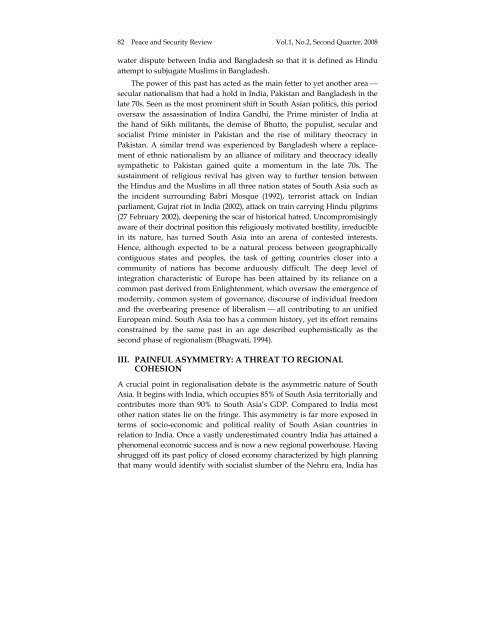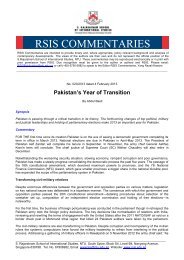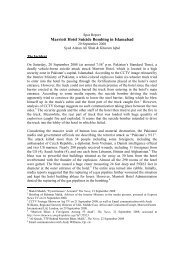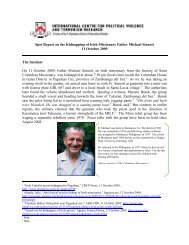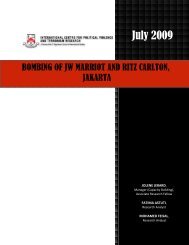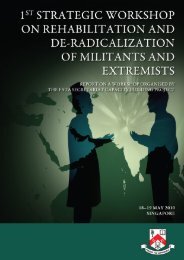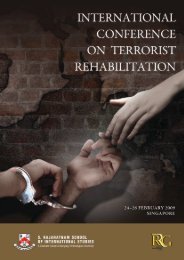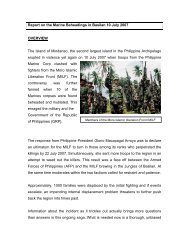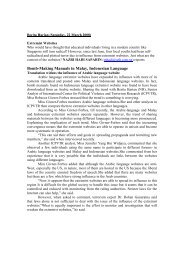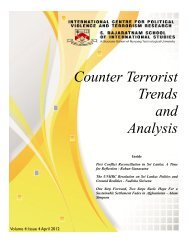Peace and Security Review, Vol.1 No. 2 - International Centre for ...
Peace and Security Review, Vol.1 No. 2 - International Centre for ...
Peace and Security Review, Vol.1 No. 2 - International Centre for ...
You also want an ePaper? Increase the reach of your titles
YUMPU automatically turns print PDFs into web optimized ePapers that Google loves.
82 <strong>Peace</strong> <strong>and</strong> <strong>Security</strong> <strong>Review</strong> <strong>Vol.1</strong>, <strong>No</strong>.2, Second Quarter, 2008<br />
water dispute between India <strong>and</strong> Bangladesh so that it is defined as Hindu<br />
attempt to subjugate Muslims in Bangladesh.<br />
The power of this past has acted as the main fetter to yet another area ⎯<br />
secular nationalism that had a hold in India, Pakistan <strong>and</strong> Bangladesh in the<br />
late 70s. Seen as the most prominent shift in South Asian politics, this period<br />
oversaw the assassination of Indira G<strong>and</strong>hi, the Prime minister of India at<br />
the h<strong>and</strong> of Sikh militants, the demise of Bhutto, the populist, secular <strong>and</strong><br />
socialist Prime minister in Pakistan <strong>and</strong> the rise of military theocracy in<br />
Pakistan. A similar trend was experienced by Bangladesh where a replacement<br />
of ethnic nationalism by an alliance of military <strong>and</strong> theocracy ideally<br />
sympathetic to Pakistan gained quite a momentum in the late 70s. The<br />
sustainment of religious revival has given way to further tension between<br />
the Hindus <strong>and</strong> the Muslims in all three nation states of South Asia such as<br />
the incident surrounding Babri Mosque (1992), terrorist attack on Indian<br />
parliament, Gujrat riot in India (2002), attack on train carrying Hindu pilgrims<br />
(27 February 2002), deepening the scar of historical hatred. Uncompromisingly<br />
aware of their doctrinal position this religiously motivated hostility, irreducible<br />
in its nature, has turned South Asia into an arena of contested interests.<br />
Hence, although expected to be a natural process between geographically<br />
contiguous states <strong>and</strong> peoples, the task of getting countries closer into a<br />
community of nations has become arduously difficult. The deep level of<br />
integration characteristic of Europe has been attained by its reliance on a<br />
common past derived from Enlightenment, which oversaw the emergence of<br />
modernity, common system of governance, discourse of individual freedom<br />
<strong>and</strong> the overbearing presence of liberalism ⎯ all contributing to an unified<br />
European mind. South Asia too has a common history, yet its ef<strong>for</strong>t remains<br />
constrained by the same past in an age described euphemistically as the<br />
second phase of regionalism (Bhagwati, 1994).<br />
III. PAINFUL ASYMMETRY: A THREAT TO REGIONAL<br />
COHESION<br />
A crucial point in regionalisation debate is the asymmetric nature of South<br />
Asia. It begins with India, which occupies 85% of South Asia territorially <strong>and</strong><br />
contributes more than 90% to South Asia’s GDP. Compared to India most<br />
other nation states lie on the fringe. This asymmetry is far more exposed in<br />
terms of socio-economic <strong>and</strong> political reality of South Asian countries in<br />
relation to India. Once a vastly underestimated country India has attained a<br />
phenomenal economic success <strong>and</strong> is now a new regional powerhouse. Having<br />
shrugged off its past policy of closed economy characterized by high planning<br />
that many would identify with socialist slumber of the Nehru era, India has<br />
<strong>Vol.1</strong>, <strong>No</strong>.2 2008 pp.77-93


